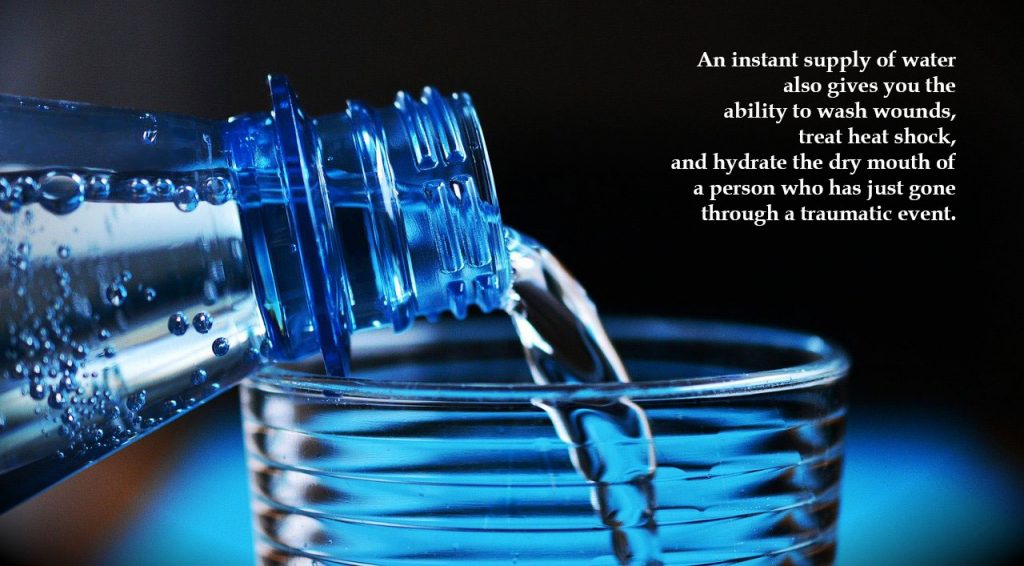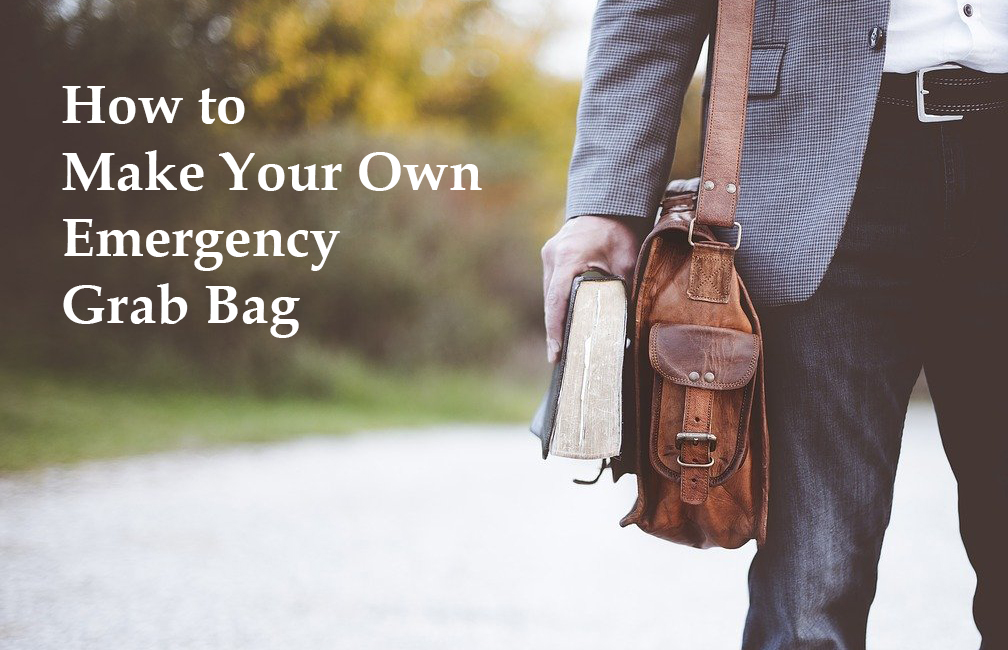
Have you ever watched a first-time mother turn up at a dinner party?
She’s got this bag of “things”.
Extra diapers for those disastrous overflow occasions. Specially scented hand wipes, anti-rash creams, the wireless two-way radio spy device, and a spare blanket because the place might have a draft.
She’s taken the time to equip herself for every eventuality.
One might say that young mothers fit into a class of prepper that excludes emergency stores of ammo, but might include an occasional conspiracy theory, like whether it’s okay to vaccinate your little bundle of mucus.
What is an emergency grab bag?
As it turns out, it’s not just mothers and preppers that need a bag like this.
Every person should have a handy grab bag for those unexpected emergency events. An emergency grab bag is a compact bag that stores a range of emergency tools and items assembled to give you a significant advantage in an emergency or disaster.
The composition of the grab bag can be as simple and as economical as you choose. No grab bag is never entirely complete, there’s always something new to add.
Of all the security projects you may need to face, this is a fun one. Approach the exercise by keeping your imagination and resourceful mindset open to new ideas and discoveries.
Choosing the right bag
You may choose to use a bag lying around the house or purposefully go out and purchase one.

Backpacks work best for a large collection of items. Smaller bags can come in the form of a pouch with a shoulder strap or can simply attach to your belt or leg.
Criteria for the bag include the following:
- The bag must have some form of strapping so that you can move with it in a hands-free manner. If you are going for a backpack, then I prefer one with a hip strap. This will give your shoulders some support if you are going to walk any distance and may also need to carry something awkward, like an uncooperative toddler in your arms.
- The bag should be able to entirely seal shut so as to withstand being turned upside down or violently shaken, without spilling its items.
- The bag should have various separately-sealed compartments. This allows you to prioritize your equipment so you can easily reach the most critical equipment first.
Where to keep your bag
Your bag might live in the corner of your kitchen, in the trunk of your car, or it might be an equipment-set that rests in your laptop bag during your daily public transport commute.
The important principle to remember is that the most useful piece of equipment you have is the one that you have with you right now.
Start by picking a bag that is going to comfortably fit your lifestyle.
If it’s too big or you feel doesn’t blend into your personal image, it will inevitably be left behind the old mail-order exercise machine. Many people construct bags that look militaristic in nature.
Remember this may attract attention.
The bag will either convey a message a
bout you or will be “grey” enough to be ignored by those who are watching. The bag needs to be convenient enough to be part of your everyday life.
Before you shrug this off as some kind of a “prepper thing”, you need to think a little more like that first-time mom.
Facing a vehicle collision, street riot, bush fire or a storm flood could happen to anyone. In fact, there are thousands of “anyones” that unexpectedly face emergencies on a daily basis worldwide.
People who are prepared for trauma do much better during the event and tend to recover faster afterward.
Picking the items for your grab bag
When creating an emergency bag, survival aficionados will go into significant detail, but broadly speaking there are three types of bag you could create.
There’s the Everyday Carry Ba
g or “EDC” as the pros call it. Then there are carry bags you might want to customize for a specific trip or for your specific environment.
This equipment might have a more urban or rural orientation. The equipment should at least accommodate your everyday immediate environment.
You might have some of the items already at home, but if you are starting from scratch, you need to take a shopping trip.
Your bag will be filled at three types of retail outlets: camping stores, pharmacies, and hardware stores. Our driving principle is to design your kit for success. Every grab-bag will have certain non-negotiable basics:
- Something to create light
- A medical kit
- Utility tools
- Something to generate warmth
- Something to keep you safe
- A communications tool or two
Let’s consider these items in a little more detail.
Create light
You can never have too much light.
If space provides, I suggest two devices. Firstly, a strong flashlight that covers some distance and gives you the opportunity to asse
ss your environment.
Secondly, a headlamp that gives you the ability to become hands-free. It is hard to get up a tree with a four-year-old in one arm and a flashlight in the other.
Medical kit
Prepacked medical kits vary in size and detail. Put on your “first-time mom” brain and check the equipment list.

Most kits have certain basics, but it’s worth adding a few extra items that might be missing. This includes burn shield dressings, a bulky dressing for large wounds, lots of medical gloves, and if possible, a tourniquet.
Multi-tools, knives and the hardware store
A multitool that includes plyers, wire stripper, flat and star screwdrivers can cover many of your tool requirements. Other items like zip-ties are also incredibly versatile allies for quickly creating structures or even making makeshift splints.
Choosing a knife can always be a difficult choice. Big, small or medium? Folding or fixed? This is a discussion for an entire
post, and any knife geek will quickly take you down the path of steel types, folding mechanisms and sheaths. For starters, pick a size that will fit well with the other equipment in your bag. Don’t assume that you are going to be fighting off hordes of zombies with your new battle blade. The knife must fit comfortably in your hand and must be suitable for a variety of tasks. Its better to see your knife as a tool rather than as a weapon. You might need it to shorten a piece of cardboard, reshape piece of wood or slice up a some food from the grill. Zombie fighting is an added extra.
Folding knives are compact. With a little practice they can be opened and closed with one hand. Fixed blades on the other hand, might take up a little space but wont close on your hands when put under stress.

Stash some cash
Take a tip from the world-famous British SAS. Each of these elite soldiers carries gold sovereigns in his belt as part of his escape and evasion kit.
In times of crisis, credit cards will do nothing for you, but the good ol’ green stuff can get you transport, food, and shelter.
Water
In a disaster environment, potable water may not be available.
An instant supply of water also gives you the ability to wash wounds, treat heat shock, and hydrate the dry mouth of a person who has just gone through a traumatic event.

Add a water bottle and a water purification device. The camping store guy will help you with this.
Warmth
Warmth can be generated by the space blanket in your first aid kit and some type of fire-making device.
Before you let an overzealous camping-store salesman fill your basket, it’s important to remember that you will only use equipment that is equal to your skill level.
Under crises, it’s unlikely that never used fancy gadgets will be of help to you.
Defending yourself
Self-defense tools will be governed by the laws of the place in which you live.
Again, such items need to be equivalent to your skill level and your willingness to engage in conflict.
I have often seen people carry folding knives under the guise of self-defense without the consideration of the blood-curdling violence required to use such a weapon.
Be it a pepper spray, taser, or firearm, the item needs to be quickly accessible in your time of need.
To sum up, pack the bag like the first-time mother would pack her bag. Which item would you need the quickest access to? Think about accessing this item in the dark and the chaos of a disaster.
Communicate in a crisis
Communication is a critical part of managing an emergency. Tools available may vary from the most complicated to the most simple – from smart phones to banging Morse Code on a cooking pot with a rock (ask any four year old, he’ll show you how its done).
At some point in your modern life you’ve probably run out of phone power. This can resolved by carrying a rechargeable power bank. Don’t forget to add a USB cable that fits your phone. Inexpensive solar recharging solutions are also available now. On the subject of phones, its possible that you might have a battery full of power but you might have to face the one of the greatest dreads in the modern world – no signal! Before you slump your shoulders in the face the dread of virtual darkness, you may want to add one or two more comm’s tools to the old grab bag.
Many camping stores and online shops now offer two-way radios. These are especially useful when building a rural grab bag. It enables you to multiply your resources by splitting into groups while staying in touch or even posting a guard when moving through volatile environments.
Apart from tech that can lose signal, lose power or stop working when unexpectedly taking a fall in a river you might want to revert to communication tools that are compact to pack, and simply make NOISE! Consider a small airhorn and of course, there’s the tried and trusted never run out of power, never run out of signal, never breakdown, easy to pack WHISTLE.

Grab some self-control before you grab your bag
The process starts with CRISIS! Then a few calming breaths that will help you take control of your body, then look around you, and get your eyes out of their adrenaline induced straws. Then comes your first thought, “what is the first thing I need to do”? And now your fingers do the searching as you confront each hurdle, one step at a time.
